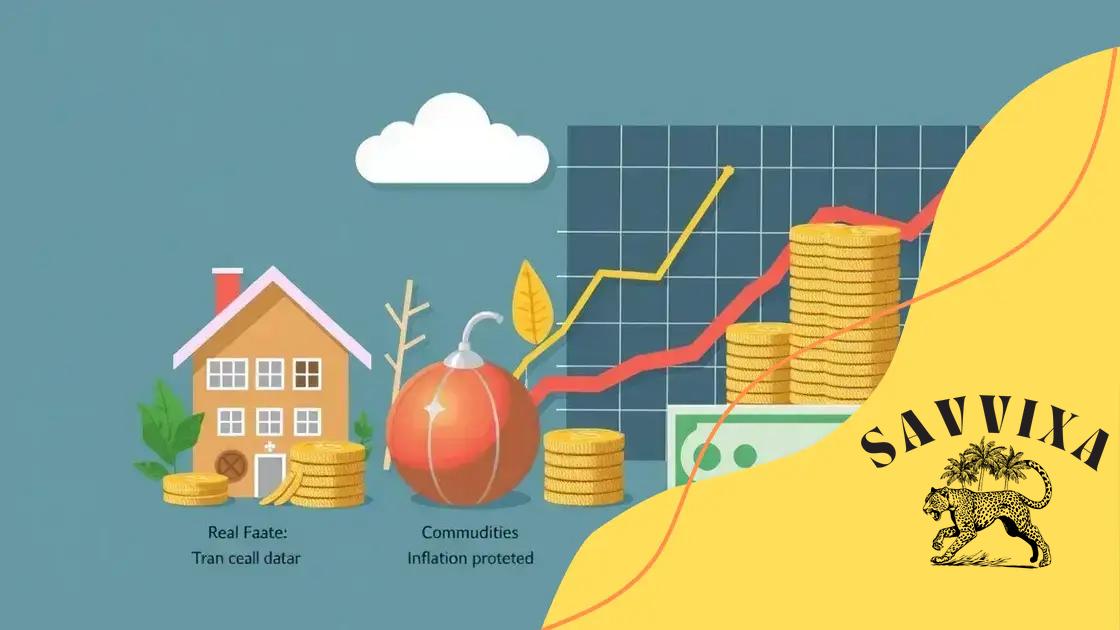The impact of inflation on global investments: what to know

The impact of inflation on global investments requires strategies like diversification, investing in real assets, and inflation-protected securities to safeguard against eroding purchasing power.
The impact of inflation on global investments can be felt across various markets, shaping decisions for both seasoned investors and newcomers. Ever wonder how inflation influences your portfolio? Let’s dive into its effects and strategies to mitigate risks.
Understanding inflation and its measurement
Understanding inflation is essential for making informed investment decisions. Inflation reflects how the purchasing power of money changes over time. When inflation rises, your money buys less, which can directly impact your savings and investments.
There are various ways to measure inflation, including the Consumer Price Index (CPI) and the Producer Price Index (PPI). The CPI tracks changes in the prices of a basket of goods and services, providing a snapshot of consumer costs. Alternatively, the PPI measures price changes from the perspective of the seller.
Key Factors Influencing Inflation
Several factors can influence inflation rates, shaping the economic landscape. Understanding these factors can help you anticipate changes in the market. Here are key considerations:
- Supply chain disruptions, which can increase costs.
- Monetary policies – how central banks control money supply.
- Demand shocks stemming from unexpected changes in consumer behavior.
- Global economic conditions that politically or financially affect markets.
Additionally, inflation can be categorized into two types: demand-pull inflation and cost-push inflation. Demand-pull inflation occurs when demand exceeds supply, driving prices up. Cost-push inflation, on the other hand, happens when production costs increase, which businesses then pass on to consumers.
As investors, it’s vital to keep a close eye on inflation trends. Recognizing the inflation rate and its measurement can give insight into investment performance and overall economic health. By staying informed, you can better navigate the effects of inflation on your investment strategies.
How inflation affects different asset classes
Understanding how inflation affects different asset classes is crucial for making smart investment choices. Various assets respond differently to changes in inflation, and recognizing these patterns can help you protect or grow your portfolio. Let’s explore how specific asset classes are impacted.
Impact on Stocks
Inflation can lead to mixed effects on the stock market. Generally, companies can pass increased costs to consumers through higher prices, which may help maintain their profit margins. However, high inflation can also lead to uncertainty, prompting investors to become more cautious.
- Growth stocks may suffer as their future earnings diminish in value.
- Value stocks tend to perform better, as they often offer dividends.
- Industries like consumer goods can thrive since they are essential products.
- Investors might shift focus to companies with strong pricing power.
The dynamic nature of stocks means that not every company will react the same way to inflation. Investors need to analyze specific sectors and companies closely.
Impact on Bonds
Bond prices usually fall when inflation rises. This happens because fixed interest payments become less attractive when rising prices reduce purchasing power.
- Long-term bonds are generally more sensitive to inflation than short-term bonds.
- Inflation-linked bonds, like TIPS, offer built-in protection against inflation.
- Rising interest rates often accompany inflation, which negatively impacts bond prices.
Investors should consider diversifying their bond holdings to buffer against inflation’s adverse effects.
Real estate is another vital asset class influenced by inflation. As prices rise, property values and rents typically increase, making real estate a potentially good hedge against inflation. Investors often turn to real estate when inflation is expected to rise, seeking capital appreciation and rental income.
Finally, commodities often perform well during inflationary periods. Materials such as gold and oil tend to increase in value as the purchasing power of currency decreases. Holding commodities in your portfolio can provide a safeguard against inflation, enhancing overall returns.
Strategies for investing during inflationary periods

Investing during periods of inflation requires a strategic approach to protect your assets. As inflation rises, the purchasing power of money diminishes, making it crucial to consider which investments can sustain or grow your wealth. Here are effective strategies to consider during inflationary times.
Real Assets
Investing in real assets is one way to hedge against inflation. Real estate and commodities tend to maintain value as prices rise. These assets can generate income through rents or appreciation, making them appealing investments during inflationary periods.
- Look for properties in strong markets that can increase in value.
- Consider investing in tangible goods like precious metals.
- Evaluate agricultural commodities that can benefit from rising prices.
These real assets can act as a buffer against the declines in your cash’s purchasing power.
Inflation-Protected Securities
Another strategy is to invest in inflation-protected securities, such as TIPS (Treasury Inflation-Protected Securities). These bonds are designed specifically to protect against inflation, as their principal increases with inflation. This means that the interest payments also rise, ensuring that you do not lose purchasing power.
- Check the yield curve for bonds to assess risk and return.
- Diversify among different maturities to manage interest rate risk.
Such investments provide a safety net during volatile economic times.
Equities are also an essential part of an inflation strategy. Certain sectors tend to perform better when inflation rises. This includes companies in consumer staples, energy, and materials, which can pass their costs onto consumers.
Investing in dividend-paying stocks can provide a hedge against inflation. Companies that regularly increase their dividends can help maintain your income stream, even as inflation erodes purchasing power. Look for firms with a solid history of dividend growth, as they may weather inflation better.
Finally, diversifying your investment portfolio is vital during inflation. Spread your investments across different asset classes to reduce risk. A balanced approach can help sustain profits and protect against inflation’s detrimental effects on specific sectors.
Case studies of inflation impacts on markets
Examining case studies of inflation impacts on markets helps to illustrate how rising prices can affect different sectors and investment strategies. By analyzing historical examples, investors can gain insights into how to navigate these economic challenges.
The 1970s Oil Crisis
One of the most notable examples is the oil crisis of the 1970s. During this period, oil prices skyrocketed due to OPEC’s actions, leading to higher energy costs and significant inflation across the globe. The U.S. faced a double-digit inflation rate, which had profound effects on the stock market and consumer behavior.
- Equities suffered as costs rose and economic uncertainty increased.
- Consumer staples and energy stocks showed resilience and even growth.
- Investors flocked to commodities like gold as a safe haven.
This case exemplifies how inflation can reshape market dynamics and investor strategies.
The 2008 Financial Crisis
Another notable instance is the financial crisis of 2008, which, while primarily a credit crisis, also highlighted inflation trends. Following the crisis, stimulus measures led to concerns about possible inflationary pressures due to increased money supply. As the economy slowly recovered, inflation began to play a more significant role.
- Precious metals rallied as investors looked for hard assets.
- Real estate markets initially suffered but later recovered, driven by lower interest rates.
- Stocks in technology sectors displayed growth as the economy stabilized.
Within this context, understanding investor behavior during inflationary pressures became crucial.
Comparing these historical instances reveals that different sectors respond uniquely to inflation. Investors must be adaptable and aware of these market changes to make informed decisions. Analyzing past performance can serve as a guide for appropriate asset allocation during inflationary periods.
Future outlook: inflation trends and investment strategies
The future outlook for inflation trends and investment strategies is a topic of great significance for investors today. As economies recover from past downturns, understanding possible inflationary pressures becomes paramount.
Potential Inflation Trends
Analysts predict several factors could influence future inflation rates, including demand recovery as economies reopen. Increased consumer spending can drive prices higher, while supply chain challenges may persist, affecting the availability of goods.
- Central banks may alter interest rates to control inflation.
- Geopolitical tensions could contribute to rising commodity prices.
- Changes in fiscal policy may further impact money supply and inflation.
Monitoring these trends can help investors stay ahead and adjust their strategies accordingly.
Investment Strategies for an Inflationary Future
In light of these trends, several investment strategies can be beneficial. Diversifying your portfolio remains key. A mix of stocks, real estate, and commodities can provide a hedge against inflation.
Investing in dividend-paying stocks can create a reliable income stream that may keep pace with inflation. Companies that regularly increase dividends often possess strong financial health, making them attractive during inflationary periods.
Real estate investment trusts (REITs) can be a solid choice as well. They typically perform well in an inflationary environment due to increasing property values and rents.
Additionally, consider allocating a portion of your portfolio to inflation-protected securities like TIPS. These investments can safeguard against inflation while providing a modest return.
Lastly, staying informed about economic signals is crucial. Keeping an eye on inflation reports, consumer price indices, and central bank decisions can help you make timely adjustments to your investment approach.
FAQ – Frequently Asked Questions about Inflation and Investment Strategies
How does inflation affect investment decisions?
Inflation erodes purchasing power, prompting investors to seek assets that can keep pace with rising prices, like real estate and commodities.
What are some effective investment strategies during inflation?
Effective strategies include diversifying your portfolio, investing in dividend-paying stocks, and considering inflation-protected securities.
Why is it important to monitor inflation trends?
Monitoring inflation trends helps investors adjust their strategies based on economic changes and avoid potential losses.
How can real estate serve as a hedge against inflation?
Real estate often increases in value during inflationary periods, and rental income can keep up with rising costs, providing a solid investment.